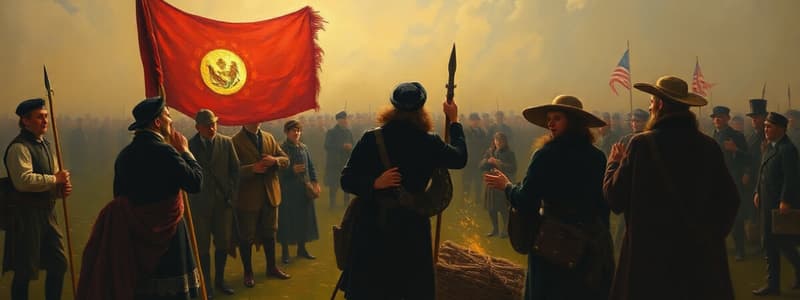Podcast
Questions and Answers
What fueled nationalist discontent leading up to the Easter Rising of 1916?
What fueled nationalist discontent leading up to the Easter Rising of 1916?
- The introduction of the English Bill of Rights
- The establishment of the British Parliament in Dublin
- The success of political negotiations in London
- The failure of the Home Rule Act of 1914 (correct)
Which of the following events characterized the initial phase of the Easter Rising in 1916?
Which of the following events characterized the initial phase of the Easter Rising in 1916?
- An organized retreat from Dublin
- Seizing key locations in Dublin (correct)
- A ceasefire agreement with British forces
- A peaceful protest at the General Post Office
Which factor contributed to the belief that the British were vulnerable at the time of the Rising?
Which factor contributed to the belief that the British were vulnerable at the time of the Rising?
- A peace treaty negotiated with Ireland
- The withdrawal of British troops from Ireland
- The ongoing conflict of World War I (correct)
- The success of the British military in Europe
What was a significant outcome of the British government's response to the Easter Rising?
What was a significant outcome of the British government's response to the Easter Rising?
Who was Padraig Pearse in relation to the Easter Rising of 1916?
Who was Padraig Pearse in relation to the Easter Rising of 1916?
What largely characterized the military capabilities of the rebels during the Easter Rising?
What largely characterized the military capabilities of the rebels during the Easter Rising?
What role did the Irish Volunteers play in the Easter Rising?
What role did the Irish Volunteers play in the Easter Rising?
In what way did the Easter Rising serve as a symbol in Irish history?
In what way did the Easter Rising serve as a symbol in Irish history?
Flashcards
Easter Rising
Easter Rising
An armed insurrection by Irish nationalists against British rule in 1916.
Irish Volunteers
Irish Volunteers
A paramilitary force formed in 1913, played a key role in planning and executing the Easter Rising.
Home Rule
Home Rule
A form of self-governance for Ireland, debated for decades, intended to grant limited autonomy.
General Post Office (GPO)
General Post Office (GPO)
Signup and view all the flashcards
Padraig Pearse
Padraig Pearse
Signup and view all the flashcards
Impact of Rising on Irish Nationalism
Impact of Rising on Irish Nationalism
Signup and view all the flashcards
Why did the Easter Rising occur?
Why did the Easter Rising occur?
Signup and view all the flashcards
What was the outcome of the Easter Rising?
What was the outcome of the Easter Rising?
Signup and view all the flashcards
Study Notes
Introduction
- The Easter Rising of 1916, also known as the 1916 Rising, was an armed insurrection by Irish nationalists against British rule.
- It was a pivotal event in Irish history, ultimately leading to Irish independence.
- The Rising involved a group of Irish nationalists who believed that peaceful methods of achieving independence had failed.
- Key figures included leaders of the Irish Volunteers and the Irish Citizen Army.
Background and Causes
- Ireland had a long history of struggle for independence from British rule.
- Home rule, a form of self-governance, had been a contentious issue for decades.
- The failure of the Home Rule Act of 1914, intended to grant Ireland limited autonomy, fueled nationalist discontent.
- World War I provided an opportunity for Irish nationalists to take action, believing that the British were distracted and vulnerable.
- Political divisions between Irish nationalists further complicated the situation. Various factions held different viewpoints on the best way to achieve independence.
- The Irish Volunteers, a paramilitary force formed in 1913, played a significant role in planning and executing the Rising.
Events of the Rising
- The Rising began on Easter Monday, April 24, 1916, in Dublin.
- The rebels seized key locations in Dublin, such as the General Post Office (GPO).
- The Rising involved a small-scale rebellion, with limited resources and manpower compared to the British forces.
- The initial response from the British was to suppress the rebellion.
- The Rising was largely confined to Dublin city.
- The key leaders of the Rising were eventually captured and executed.
Aftermath and Impact
- The British government's response to the Rising was perceived as brutal.
- The executions of the key leaders had a significant impact on public opinion, fueling and energizing the Irish republican movement.
- The Rising, despite its military failure, acted as a catalyst for increased nationalist sentiment.
- The Rising highlighted the deep divisions between Irish nationalists and the British government.
- Public sympathy for the rebels grew amidst descriptions of the harsh British responses.
- The Rising ultimately contributed to the eventual establishment of the Irish Free State.
- The 1916 Rising became a powerful symbol of Irish national identity and the desire for independence.
Key Figures
- Padraig Pearse: Leading figure in the Rising, a fervent nationalist, and later executed.
- James Connolly: Labour leader and socialist revolutionary, also a key leader and executed.
- Eamon de Valera: Important leader who escaped capture and eventually played a significant role in the subsequent struggle for independence.
Significance
- The 1916 Easter Rising was a turning point in Irish history.
- It signaled a shift from a desire for Home Rule to full Irish independence.
- The rising, along with the British response, ignited profound resentment and strengthened nationalist identity.
- It laid the groundwork for the Irish War of Independence and the eventual creation of the Irish state.
Studying That Suits You
Use AI to generate personalized quizzes and flashcards to suit your learning preferences.




